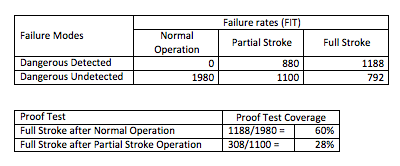I have run into this question a couple of times now and though the answer is somewhat straightforward, some customers have trouble wrapping their head around this without a clear example. So here we go…
First of all we need to keep in mind that the objective of a proof test is to reveal any failures that remain undetected during normal operation. Therefore we want to detect Dangerous Undetected failures and any diagnostic failures that would prevent the detection of failures during normal operation.
Consider a Generic Air Operated Ball Valve with a Soft Seat. The exida Safety Equipment Reliability Handbook (SERH) shows that for a normal, close on trip application where a full stroke is sufficient to achieve the safe state, the Dangerous Undetected failure rate is 1980 FIT (1 FIT = 1E-09 failures/hour). When a user executes a full stroke as part of this proof test, a Proof Test Coverage (PTC) of 60% can be claimed.
The SERH also states the failure rates for the same Generic Air Operated Ball Valve with a Soft Seat in case a static partial valve stroke test (PVST) is performed. In case a partial valve stroke test is done, a Dangerous Detected failure rate of 880 FIT and a Dangerous Undetected of 1100 FIT apply. This means that of the original 1980 FIT Dangerous Undetected failures 880 (1980 - 1100) or 44.4% can be detected as part of the partial valve stroke.
Let’s go back to the full stroke test. The proof test coverage of the full stroke test suggests that 60% of all Dangerous Undetected failures can be detected when a full stroke test is performed. Therefore after the proof test of the Dangerous Undetected failures 1188 FIT would be revealed and 792 FIT would remain unrevealed/undetected. The failures that would be detected during a full stroke test include stuck stem, some seat failures, etc. Several of these failures would be detected by a partial stroke test, e.g. stuck stem failures. Once a partial stroke test is done these stuck stem failures will no longer be dangerous undetected and therefore would not be targeted for detection during a proof test. In other words, once a failure is detected during normal operation/application level testing, it can no longer be considered detectable during the proof test.
Given the failure rates in the example above, if partial stroking is done, only 1100 FIT failures are Dangerous Undetected. After a full stroke, 792 FIT failures will remain unrevealed. So the full stroke test after a partial stroke test will only reveal 308 (1100 - 792) FIT failures. Therefore the proof test coverage for a full stroke proof test after a partial stroke test is done is 308/1100 = 28%.
This explains why the proof test coverage will decrease when partial stroke testing is implemented. It does not necessarily mean that the test is bad or the product does not allow detection of Dangerous Undetected failures. There simply are fewer failures that can be revealed.
The tables below provide a summary of the failure rates and proof test coverage factors.

Tagged as: SERH Safety Equipment Reliability Handbook PVST PTC Proof Test Coverage proof test partial valve stroke test FIT exida Dangerous Undetected failures

